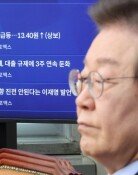Universities use old gaming chips for AI research
Universities use old gaming chips for AI research
Posted May. 04, 2024 07:28,
Updated May. 04, 2024 07:28
Universities on the front lines of the artificial intelligence (AI) technology war are grappling with research setbacks, constrained by inadequate budgets that hamper their access to the latest AI chips. Researchers are repurposing older gaming GPUs to develop generative AI models in a scramble, but they cannot secure Nvidia’s cutting-edge graphics processing units (GPUs). A common sentiment among researchers is that while other countries are "fighting with cannons, we are entering the tech war armed only with a single gun."
The root of this problem lies in the escalating prices of AI chips, which are not matched by corresponding increases in university research funding. As the AI market grows, the supply of GPUs fails to meet demand, leading to a surge in prices. Standard AI research requires a minimum investment of 500 million won, yet the average research budget per engineering faculty member, including salaries, maxes out at just 250 million won. At this rate, employing outdated equipment would take over a century to reach the current global service standard.
Compounding the issue, even when chips are procured, many universities cannot use them due to a lack of available power; professors are forced to search for buildings with excess electrical capacity. The power infrastructure is saturated, with no plans to increase capacity. The government’s initiative to freely distribute GPUs to enterprises and academic institutions falls significantly short of the demand. In contrast, the United States benefits from large-scale corporate donations and investments that supply universities with GPUs, and Canada supports its academic institutions with a cooperative approach to data and computing infrastructure.
Furthermore, the development of the sixth iteration of the national strategic asset in the AI competition, the supercomputer, is stagnating due to insufficient funds. This challenging research environment is prompting a brain drain, with a notable exodus of AI talent moving abroad, turning the country into a net exporter of AI expertise. Despite the government's ambitious blueprint to elevate the nation into the AI G3, this vision risks becoming mere rhetoric if the underlying issue of inadequate research infrastructure continues to be ignored.
Nations worldwide are engaging in a full-scale national effort to seize the helm of the AI technology war. The government has pledged an investment of 9.4 trillion won in the AI and AI semiconductor sectors by 2027, which requires careful planning and effective execution. It is critical to foster private investment and raise the bar for R&D by developing infrastructure and recruiting talent. With AI still in its nascent stages, a window exists for early dominance; however, further delays could lead to missed opportunities forever.
Headline News
- Harris ‘first female president’ vs. Trump ‘again 2016’
- N. Korea builds 11-meter rampart after road demolition
- Democratic Party eventually agrees to abolish financial investment income tax
- Drug smuggling is seized twice a day on average this year
- Surrounded by ‘uniforms,’ NHL’s first female coach ‘time-out’







